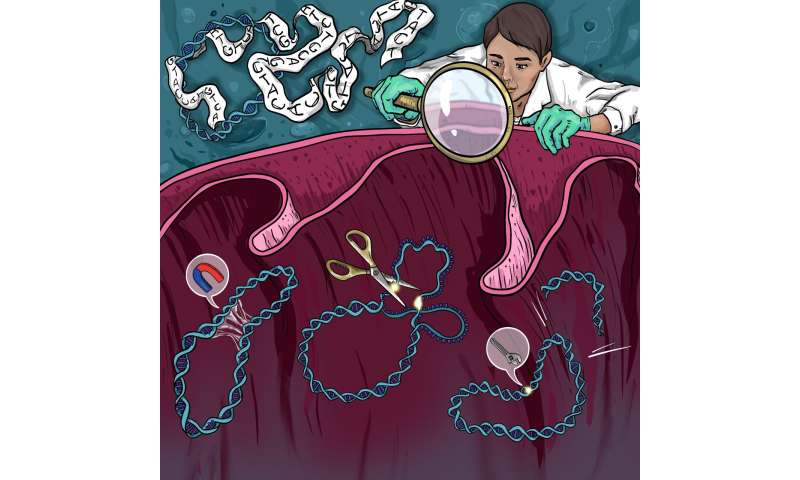How do batteries of our body break?

With aging mitochondria—powerhouses of cells—can lose fragments of their DNA, that leads to different pathologies, especially as far as brain and muscles is concerned. Thus understanding of the mechanism of deletion of fragments of mitochondrial DNA is highly important, because this information will enable to elaborate the method of preventing the degradation of vital tissues. International group, that includes members of Immanuel Kant Baltic Federal University, has found out that some parts of mitochondrial genome are situated in the region of higher risk due to the properties they possess. The results of the research, published in magazine BMC Biology, will help to predict risks of certain diseases, connected with mutations of mitochondrial DNA, that enables to improve methods of their treatment and prevention.
Aging is a complex process, caused by a whole range of mechanisms. One of them can be connected with the distortion of work of mitochondria, that produce energy in the cell. The shortage of energy that emerges with aging and causes the development of serious diseases, that lead to weakening of muscles and brain, is obviously connected with mutations in mitochondrial DNA (mtDNA).
In the cell there are a lot of regularly dividing mitochondria, each of which bears its own genetic material. Normally it is practically the same, but with time more differences are accumulated. In the case of some mutations, for example, the deletion of fragments of nuclear chain (deletion), these defective mtDNA can get an advantage by copying and information reading because they don't spend time on translation. Thus, the number of "damaged" proteins in the cell increases that in the end leads to its degradation. Simply speaking, in the course of time all area will be occupied by small and rapidly multiplying mitochondria, while strong and hardy mitochondria will be outnumbered. There is one cell genome in each cell, and the whole population are carriers of mtDNA. That means that in each cell of our body lives population of mitochondria, inside which intracellular natural selection takes place, in course of which this population changes.
Up to date there exists no commonly accepted hypothesis, why deletions are formed in mitochondrial genome and is it normal in the stage of aging. Specialists from Centre of Genome Research from Immanuel Kant Baltic Federal University together with Russian and foreign colleagues tried to study the molecular mechanisms of this phenomenon. The object of their research became the part of mitochondrial genome, that due to peculiarities of DNA replication is more often single-stranded (normally DNA is double-stranded and winded, while during replication it for a certain time unwinds and becomes single-stranded). They analyzed information about more than 1300 deletions from the open base MitoBreak and found out that such mutations were spread in genome not evenly, but were concentrated in a particular spot. What makes this spot so peculiar? Why is it so fragile and predisposed to deletions? The scientists tried to answer these vital and interesting questions in their work.

"Here we've found a large-scale loop, that forms hairpin-like structure with the contacting regions between parts 6-9 and 13-16 kb pairs of nucleotides. It emerges due to the fact that these two mtDNA regions are very close during replication, and due to the existence of the similar fragments inside these regions can correlate with each other",—explains Victor Shamansky, post-graduate student of the 4th year of study, junior research scientist of the Centre of Genome Research.
Duplications (similar fragments) in DNA in general are considered "hot spots" for mutations, such as deletions: enzymes, that double DNA chains, can easily "slip" and make a mistake in the process of replication. However, as authors state, in the case of mitochondrial genome they can't be considered the main generators of loss of hereditary information. As computer modelling has shown, there is another factor, the structural one, that influences the emergence of deletions thrice greater.
"In the process of synthesis of daughter strands the original mother chain unwinds, in order that enzymes can move along it, but these regions of repetition bind with each other. Form of mitochondrial DNA can remind "symbol of eternity", with contact zones between two its parts, and synthesis can stop here. You can present mtDNA as elastic ring like a low tire, and repetitions like double-sided adhesive tape on it. By this the elasticity of the ring is uneven, some places bend more easily, and some harder. The ring can stick together only in those places with tape that we can make touch each other—that to make contact zone",—tells Konstantin Popadin, Ph.D.Biology, senior scholar of Centre of Genome Researches.
The conclusions made can help to predict risks of some diseases connected with mutations of mtDNA, including those connected with aging. Nowadays scientists from Center of Genome Research of Immanuel Kant Baltic Federal University are working on spreading the obtained in the research results on various haplogroups—the collection (cluster) of nucleotides, inherited from mutual predecessor, for example, at the particular area.
Authors are elaborating a unified conception, the target of which is the revealing of fragile areas in mitochondrial genome of each man, in other words the individual analysis of risk of forming of deletions, which further can be treated with the help of methods of gene therapy.
More information:
Victor Shamanskiy et al, Secondary structure of the human mitochondrial genome affects formation of deletions, BMC Biology (2023). DOI: 10.1186/s12915-023-01606-1
Provided by Immanuel Kant Baltic Federal University